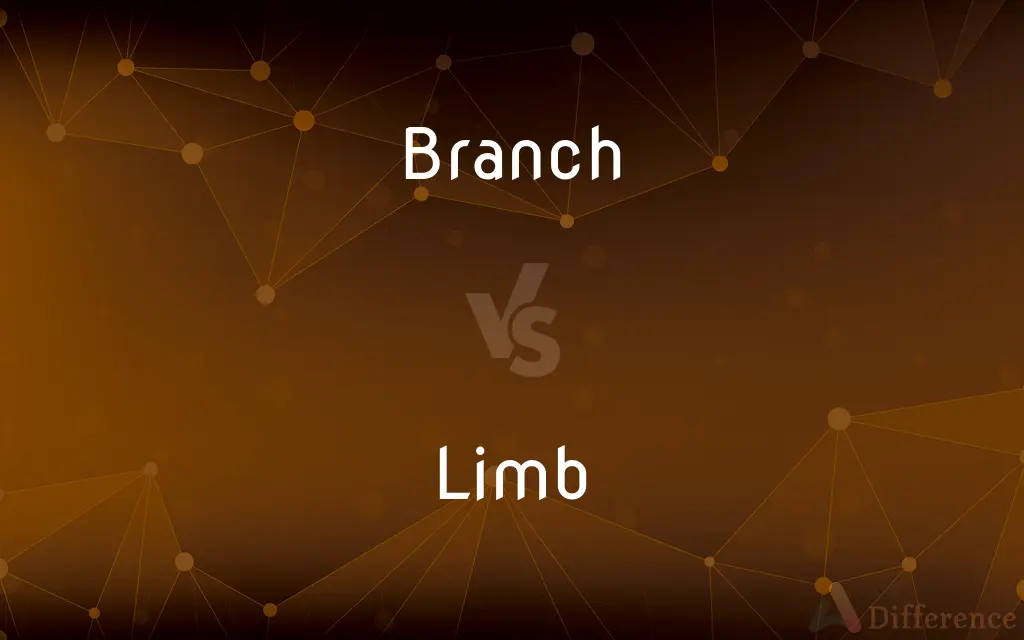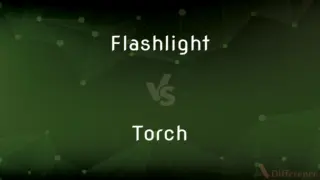Branch vs. Limb — What's the Difference?
By Fiza Rafique & Urooj Arif — Updated on March 31, 2024
A branch is a secondary extension of a tree's trunk, primarily for bearing leaves, flowers, and fruits, while a limb can be a large branch or an arm/leg of an animal, including humans.

Difference Between Branch and Limb
Table of Contents
ADVERTISEMENT
Key Differences
Branches are integral parts of a tree's anatomy, serving mainly to expand the tree's canopy for better sunlight absorption and support for leaves, flowers, and fruits. Whereas limbs, in botanical terms, refer to the larger branches of a tree but in anatomy, they describe the arms and legs of animals and humans.
Branches grow from the trunk of a tree and can further subdivide into smaller branches and twigs, playing a key role in photosynthesis and the tree's overall growth. On the other hand, limbs, when referring to body parts, are vital for mobility and interaction with the environment, enabling locomotion in animals and various physical activities in humans.
The growth and development of branches are influenced by environmental factors and the tree's genetic makeup, determining their direction, thickness, and length. In contrast, the development of limbs in animals and humans is influenced by genetic factors and can be affected by physical activity, health, and injuries.
Pruning is a common practice for managing the growth and health of branches, enhancing a tree's aesthetic appeal and preventing disease spread. Limbs, however, require medical attention when injured or diseased, with treatments ranging from physical therapy to surgical intervention.
Branches can be used metaphorically to describe divisions within organizations or areas of knowledge. Meanwhile, limbs, especially in humans, are often referenced in expressions and idioms, highlighting their importance in physical and symbolic strength.
ADVERTISEMENT
Comparison Chart
Definition
A secondary extension of a tree's trunk, mainly for leaves, flowers, and fruits.
In botany, a large branch; in anatomy, an arm or leg of an animal/human.
Function
Supports photosynthesis, growth, and reproduction in trees.
Enables mobility and manipulation of the environment; supports body weight.
Growth Factors
Environmental conditions, tree genetics.
Genetics, health, physical activity, and injuries.
Maintenance
Pruning for health and aesthetics.
Medical attention for injuries or diseases; physical therapy.
Metaphorical Use
Divisions within organizations or fields of knowledge.
Expressions emphasizing physical or symbolic strength.
Compare with Definitions
Branch
A subdivision of a tree's trunk, bearing leaves and possibly flowers and fruits.
The apple tree's branches were heavy with ripe fruit.
Limb
An arm or leg of a human or animal.
The cat injured its limb climbing the tree.
Branch
An offshoot of a plant stem.
A new branch sprouted from the rose stem after pruning.
Limb
In botany, a large or main branch of a tree.
The storm caused the tree's largest limb to break.
Branch
An extension or part of a network.
The river's branch flowed quietly through the forest.
Limb
A component of a mechanical system that mimics the action of a human limb.
The robot's limb was designed for precise movements.
Branch
A division within an organization or system.
The local branch of the library system hosted a community event.
Limb
A supporting structure in architecture or design, resembling an arm or branch.
The chandelier's limbs spread out elegantly over the dining table.
Branch
A field or area of knowledge or activity.
She specialized in a niche branch of molecular biology.
Limb
A crucial part or member of a group.
As the lead guitarist, she was a vital limb of the band.
Branch
A branch (UK: or UK: , US: ) or tree branch (sometimes referred to in botany as a ramus) is a woody structural member connected to but not part of the central trunk of a tree (or sometimes a shrub). Large branches are known as boughs and small branches are known as twigs.
Limb
One of the larger branches of a tree.
Branch
A part of a tree which grows out from the trunk or from a bough
Sophie was in the branches of a tree eating an apple
Limb
One of the jointed appendages of an animal, such as an arm, leg, wing, or flipper, used for locomotion or grasping.
Branch
(of a road or path) divide into one or more subdivisions
Follow this track south until it branches into two
Limb
An extension or a projecting part, as of a building or mountain range.
Branch
(of a tree or plant) bear or send out branches
This rose has a tendency to branch and spread at the top
The branching heads of large yellow daisies
Limb
An extension or part distinguished from the main body or group
The conservative limb of the party.
Branch
A secondary woody stem or limb growing from the trunk or main stem of a tree or shrub or from another secondary limb.
Limb
A member or representative of a group
Was arrested by a burly limb of the law.
Branch
A lateral division or subdivision of certain other plant parts, such as a root or flower cluster.
Limb
(Archaic)An impish child.
Branch
A secondary outgrowth or subdivision of a main axis, such as the tine of a deer's antlers.
Limb
(Astronomy)The circumferential edge of the apparent disk of a celestial body.
Branch
(Anatomy) An offshoot or a division of the main portion of a structure, especially that of a nerve, blood vessel, or lymphatic vessel; a ramus.
Limb
(Mathematics)The edge of a graduated arc or circle used in an instrument to measure angles.
Branch
An area of specialized skill or knowledge, especially academic or vocational, that is related to but separate from other areas
The judicial branch of government.
The branch of medicine called neurology.
Limb
(Botany)The expanded tip of a plant organ, such as a petal or corolla lobe.
Branch
A division of a business or other organization.
Limb
To remove the branches from.
Branch
A division of a family, categorized by descent from a particular ancestor.
Limb
A major appendage of human or animal, used for locomotion (such as an arm, leg or wing).
Branch
(Linguistics) A subdivision of a family of languages, such as the Germanic branch of Indo-European.
Limb
A branch of a tree.
Branch
A tributary of a river.
Limb
(archery) The part of the bow, from the handle to the tip.
Branch
Chiefly Southern US See creek. See Note at run.
Limb
An elementary piece of the mechanism of a lock.
Branch
A divergent section of a river, especially near the mouth.
Limb
A thing or person regarded as a part or member of, or attachment to, something else.
Branch
(Mathematics) A part of a curve that is separated, as by discontinuities or extreme points.
Limb
(astronomy) The apparent visual edge of a celestial body.
The solar limb
Branch
A sequence of program instructions to which the normal sequence of instructions relinquishes control, depending on the value of certain variables.
Limb
(on a measuring instrument) The graduated edge of a circle or arc.
Branch
The instructions executed as the result of such a passing of control.
Limb
(botany) The border or upper spreading part of a monopetalous corolla, or of a petal or sepal; blade.
Branch
(Chemistry) A bifurcation in a linear chain of atoms, especially in an organic molecule where isomeric hydrocarbon groups can vary in the location and number of these bifurcations of the carbon chain.
Limb
(transitive) To remove the limbs from (an animal or tree).
They limbed the felled trees before cutting them into logs.
Branch
To put forth a branch or branches; spread by dividing.
Limb
(transitive) To supply with limbs.
Branch
To come forth as a branch or subdivision; develop or diverge from
An unpaved road that branches from the main road.
A theory that branches from an older system of ideas.
Limb
A part of a tree which extends from the trunk and separates into branches and twigs; a large branch.
Branch
(Computers) To relinquish control to another set of instructions or another routine as a result of the presence of a branch.
Limb
An arm or a leg of a human being; a leg, arm, or wing of an animal.
A second Hector for his grim aspect,And large proportion of his strong-knit limbs.
Branch
To separate (something) into branches.
Limb
A thing or person regarded as a part or member of, or attachment to, something else.
That little limb of the devil has cheated the gallows.
Branch
To embroider (something) with a design of foliage or flowers.
Limb
An elementary piece of the mechanism of a lock.
Branch
The woody part of a tree arising from the trunk and usually dividing.
Limb
A border or edge, in certain special uses.
Branch
Any of the parts of something that divides like the branch of a tree.
The branch of an antler, a chandelier, or a railway
Limb
To supply with limbs.
Branch
A creek or stream which flows into a larger river.
Branch water
Limb
To dismember; to tear off the limbs of.
Branch
(geometry) One of the portions of a curve that extends outwards to an indefinitely great distance.
The branches of a hyperbola
Limb
One of the jointed appendages of an animal used for locomotion or grasping: arm; leg; wing; flipper
Branch
A location of an organization with several locations.
Our main branch is downtown, and we have branches in all major suburbs.
Limb
Any of the main branches arising from the trunk or a bough of a tree
Branch
A line of family descent, in distinction from some other line or lines from the same stock; any descendant in such a line.
The English branch of a family
Limb
(astronomy) the circumferential edge of the apparent disc of the sun or the moon or a planet
Branch
(Mormonism) A local congregation of the LDS Church that is not large enough to form a ward; see Wikipedia article on ward in LDS church.
Limb
Either of the two halves of a bow from handle to tip;
The upper limb of the bow
Branch
An area in business or of knowledge, research.
Limb
Any projection that is thought to resemble an arm;
The arm of the record player
An arm of the sea
A branch of the sewer
Branch
(nautical) A certificate given by Trinity House to a pilot qualified to take navigational control of a ship in British waters.
Branch
(computing) A sequence of code that is conditionally executed.
Branch
(computing) A group of related files in a source control system, including for example source code, build scripts, and media such as images.
Branch
(rail transport) A branch line.
Branch
(intransitive) To arise from the trunk or a larger branch of a tree.
Branch
(intransitive) To produce branches.
Branch
(ambitransitive) To (cause to) divide into separate parts or subdivisions.
Branch
To jump to a different location in a program, especially as the result of a conditional statement.
Branch
(transitive) To strip of branches.
Branch
To discipline (a union member) at a branch meeting.
Branch
A shoot or secondary stem growing from the main stem, or from a principal limb or bough of a tree or other plant.
Branch
Any division extending like a branch; any arm or part connected with the main body of thing; ramification; as, the branch of an antler; the branch of a chandelier; a branch of a river; a branch of a railway.
Most of the branches , or streams, were dried up.
Branch
Any member or part of a body or system; a distinct article; a section or subdivision; a department.
It is a branch and parcel of mine oath.
Branch
One of the portions of a curve that extends outwards to an indefinitely great distance; as, the branches of an hyperbola.
Branch
A line of family descent, in distinction from some other line or lines from the same stock; any descendant in such a line; as, the English branch of a family.
His father, a younger branch of the ancient stock.
Branch
A warrant or commission given to a pilot, authorizing him to pilot vessels in certain waters.
Branch
Diverging from, or tributary to, a main stock, line, way, theme, etc.; as, a branch vein; a branch road or line; a branch topic; a branch store.
Branch
To shoot or spread in branches; to separate into branches; to ramify.
Branch
To divide into separate parts or subdivision.
To branch out into a long disputation.
Branch
To divide as into branches; to make subordinate division in.
Branch
To adorn with needlework representing branches, flowers, or twigs.
The train whereof loose far behind her strayed,Branched with gold and pearl, most richly wrought.
Branch
An administrative division of some larger or more complex organization;
A branch of Congress
Branch
A division of a stem, or secondary stem arising from the main stem of a plant
Branch
A part of a forked or branching shape;
He broke off one of the branches
They took the south fork
Branch
A natural consequence of development
Branch
A stream or river connected to a larger one
Branch
Any projection that is thought to resemble an arm;
The arm of the record player
An arm of the sea
A branch of the sewer
Branch
Grow and send out branches or branch-like structures;
These plants ramify early and get to be very large
Branch
Divide into two or more branches so as to form a fork;
The road forks
Common Curiosities
What is the primary function of a branch?
Branches primarily serve to support leaves for photosynthesis, contributing to a tree's growth and reproduction.
How do branches grow?
Branches grow from the trunk or from other branches, influenced by environmental factors and the tree's genetics.
Can a limb refer to something other than a body part?
Yes, in botany, a limb can refer to a large or main branch of a tree.
What influences the development of limbs in humans and animals?
The development is influenced by genetics, and can be affected by health, physical activity, and injuries.
Why are branches pruned?
Branches are pruned to manage a tree's health and aesthetic appeal, and to prevent disease spread.
Are limbs important for mobility?
Yes, limbs are essential for mobility and manipulation of the environment in animals and humans.
How are injured limbs treated?
Injured limbs may require medical attention, including physical therapy or surgical interventions.
Can limbs be non-biological?
Yes, limbs can refer to mechanical or architectural structures that mimic the function or appearance of biological limbs.
What does a limb in architecture refer to?
In architecture, a limb can refer to a supporting structure that resembles an arm or branch in form or function.
Is there a difference in maintenance between branches and limbs?
Yes, branches are maintained through pruning, while limbs, especially human, may require medical care for upkeep.
Do branches have a role in reproduction?
Yes, branches bear flowers and fruits, playing a crucial role in a tree's reproductive processes.
What factors affect branch growth?
Branch growth is affected by environmental conditions and the genetic makeup of the tree.
What metaphorical meanings do branches have?
Branches can metaphorically represent divisions within organizations or areas of knowledge.
How does pruning benefit a tree?
Pruning can enhance a tree's growth, health, and form, and prevent disease.
Can limbs refer to mechanical components?
Yes, limbs can describe components of a mechanical system that mimic human arm or leg actions.
Share Your Discovery

Previous Comparison
Flashlight vs. Torch
Next Comparison
Polystyrene vs. PolyethyleneAuthor Spotlight
Written by
Fiza RafiqueFiza Rafique is a skilled content writer at AskDifference.com, where she meticulously refines and enhances written pieces. Drawing from her vast editorial expertise, Fiza ensures clarity, accuracy, and precision in every article. Passionate about language, she continually seeks to elevate the quality of content for readers worldwide.
Co-written by
Urooj ArifUrooj is a skilled content writer at Ask Difference, known for her exceptional ability to simplify complex topics into engaging and informative content. With a passion for research and a flair for clear, concise writing, she consistently delivers articles that resonate with our diverse audience.














































